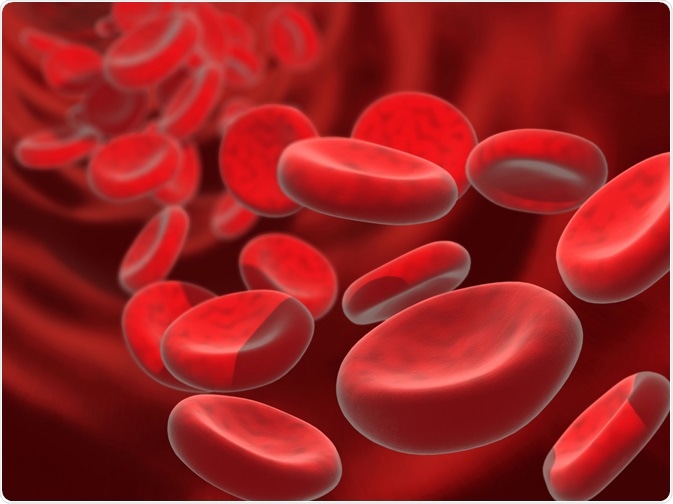Hematopoiesis is the process of blood cell renewal in the body and occurs throughout adulthood. Growth factors enable the tight regulation of hematopoiesis, enabling new blood cells to differentiate, proliferate, and mature.
 YAKOBCHUK VASYL | Shutterstock
YAKOBCHUK VASYL | Shutterstock
Blood cells have various lifespans and it is essential that they are replenished on a continual basis. Several cytokines enable the differentiation, proliferation, and maturation of eight types of blood cell. Some act upon a range of cell lineages, while others are highly specific.
Erythropoietin
Erythropoietin (EPO) regulates the process of erythropoiesis. This growth factor is a highly glycosylated polypeptide and is mainly produced in the kidneys. In a state of hypoxia (deficiency in oxygen supply to the tissues), the production of erythropoietin is stimulated by HIF‐1α and β (two types of hypoxia inducible factors).
EPO stimulates an increased number of myeloid progenitor cells to undergo erythropoiesis. The transcription factor GATA-2 initiates the erythroid maturation pathway. The earliest erythroid progenitors burst, forming unit-erythroid (BFUE) and erythroid colony forming unit (CFUE) both have receptors for erythropoietin on their surfaces. When EPO binds to these receptors, proliferation, differentiation, and the production of haemoglobin is stimulated.
Thrombopoietin
The majority of thrombopoietin (TPO) is produced in the liver (95%) and is responsible for the regulation of thrombocyte production. TPO enables the fragmentation of megakaryocytes in the bone marrow.
Sialic acid is lost from thrombocytes as they come to the end of their lifespan (which is approximately 10 days). This leaves galactose residues exposed so that they can bind to Ashwell-Morell receptors in the liver. This triggers the production of TPO. TPO works to increase both the number and maturation of megakaryocytes by binding at c-MPL receptors.
Stem Cell Factor
Stem Cell Factor (SCF) also known as kit ligand which plays an integral role to regulate adult and embryonic hematopoiesis. SCF binds a tyrosine kinase receptor, c-kit, which results in the dimerization of the c-kit receptor and the subsequent activation of the tyrosine kinase domain.
Gene expression, cell proliferation and prevention of apoptosis are initiated by phosphorylation of tyrosine residues at the receptor site. This enables the binding of signalling proteins which allow these types of biochemical events to occur.
Interleukin 3 (IL-3), Interleukin 5 (IL-5) and Granulocyte Macrophage Colony Stimulating Factor (GM-CSF)
Derived from T-cells, IL-3 is required for the survival and proliferation of primitive hematopoietic progenitor cells. Much of its activity overlaps with IL-5 and GM-CSF, two other growth factors implicated in the hematopoietic process. Each of these ligands is made up of a cytokine alpha unit and the common beta subunit. This enables them to bind to the beta common receptor.
The differentiation of hematopoietic stem cells (HSCs) into myeloid progenitor cells is stimulated by IL-3. IL-3 in tandem with IL-7 enables the differentiation of HSC into lymphoid progenitor cells. This cytokine also works alongside GM-CSF to encourage the proliferation of cells in the myeloid lineage.
HSCs stimulated by GM-CSF produce both monocytes and granulocytes. GM-CSF is also known to prevent the migration of neutrophils.
IL-5 is produced by mast cells and T helper cells. Unlike IL-3 and GM-CSF, which act upon various cell lineages, IL-5 is primarily responsible for the maturation and release of eosinophils but it stimulates the differentiation of B-cells.
Further Reading